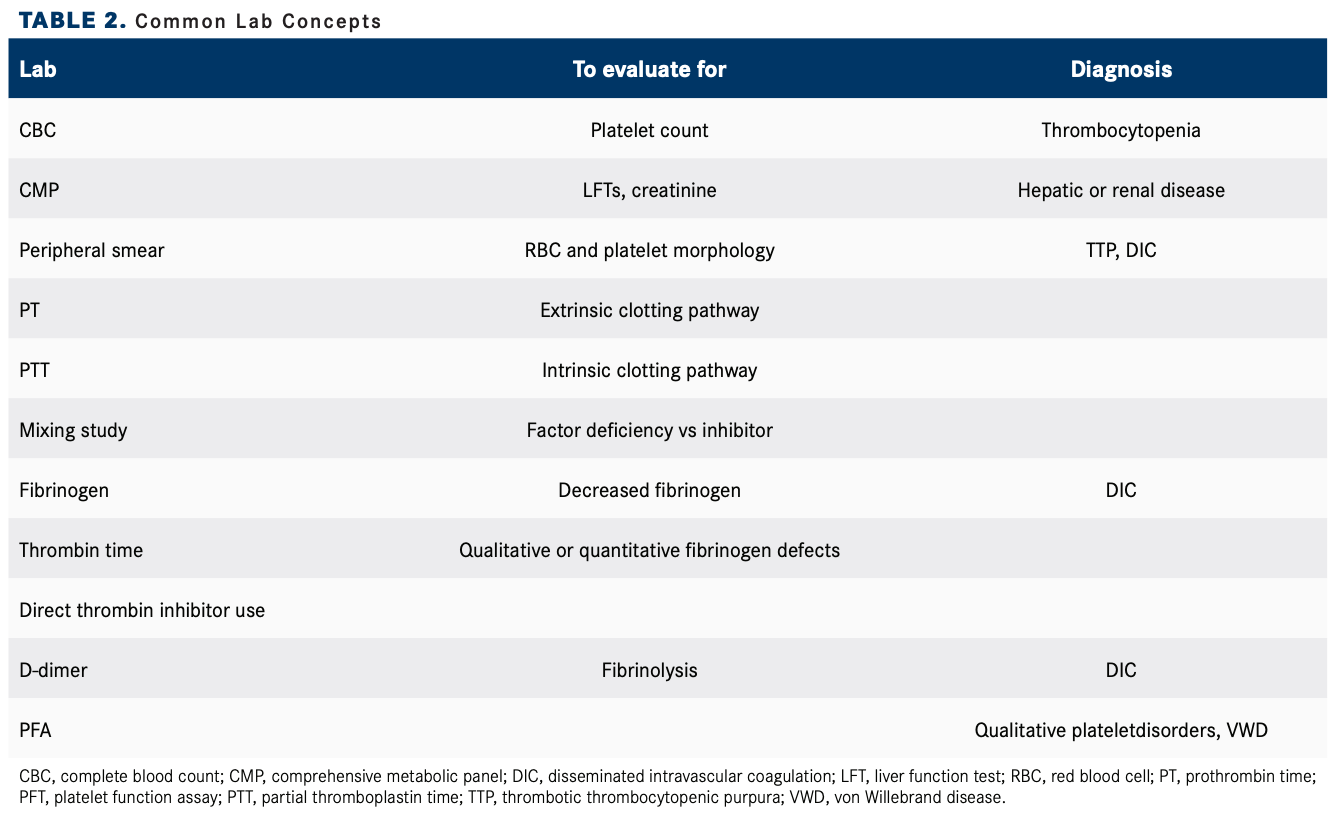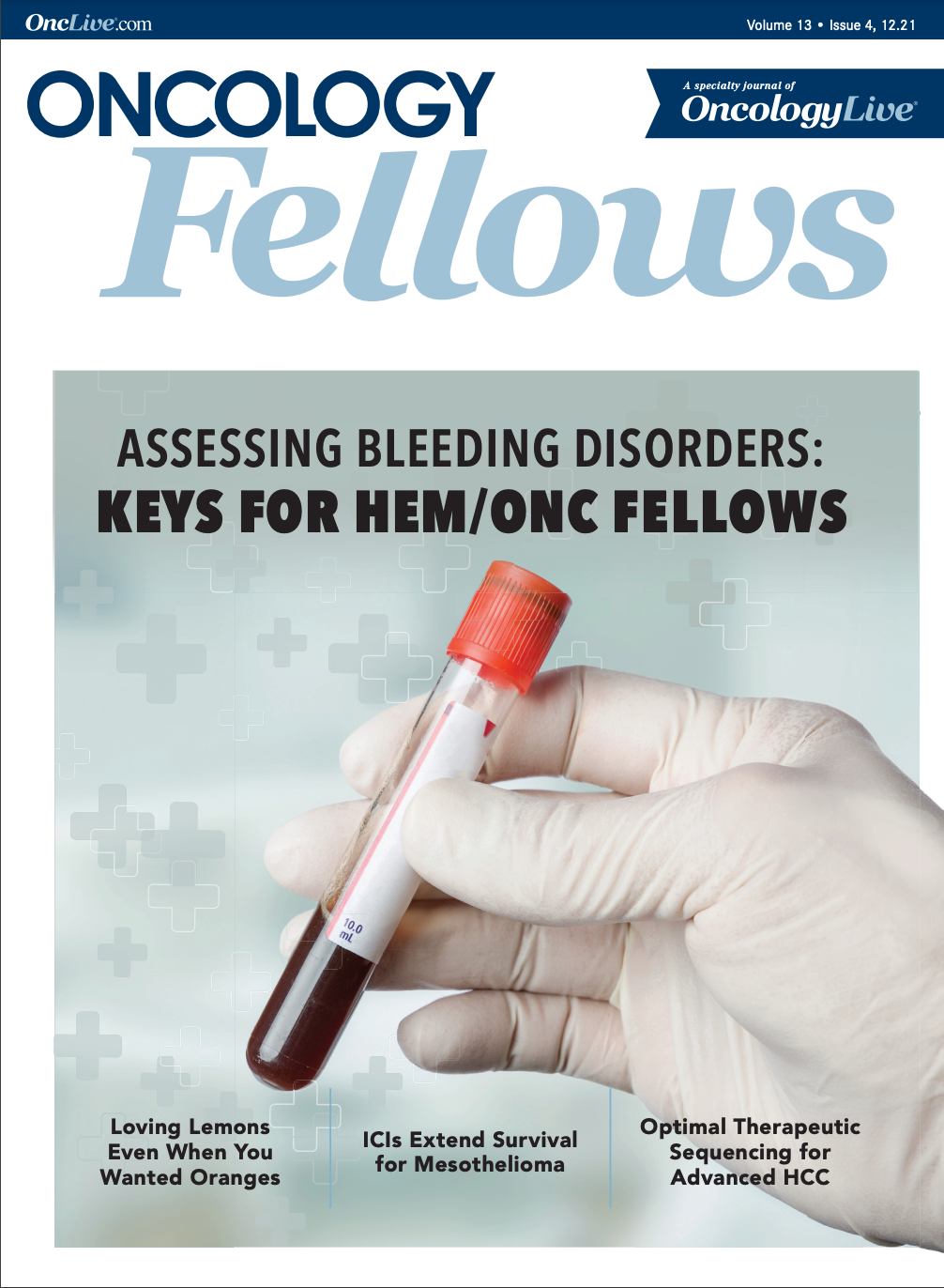Publication
Article
Assessing Bleeding Disorders: Keys for Hem/Onc Fellows
Author(s):
Michelle Chi, MD and Jennifer R. Green, MD, share practical points for trainees to approach the initial evaluation for a bleeding-disorder patient.
Michelle Chi, MD

One challenging hematologic scenario dreaded by both fellows and faculty involves a rapidly bleeding patient in danger of exsanguination. Conversely, the ability to successfully intervene can be quite rewarding and save lives. What follows are practical points for trainees to approach the initial evaluation for a bleeding-disorder patient.
Jennifer R. Green, MD

Step 1: Obtain a Thorough History
History is vital to inform differential diagnosis and target lab evaluation. Important aspects include timing and details surrounding the bleeding events, reviewing medications/substance use, and family history.1 Important considerations include:
A. TIMING Clinically relevant hemorrhage in infancy or childhood is suggestive of an inherited/ congenital bleeding disorder. Hemorrhage in adulthood should prompt an evaluation for an acquired coagulation disorder, a delayed manifestation of a mild congenital bleeding disorder, or a medication effect.
B. PROVOCATION Is the bleeding spontaneous or only with trauma or invasive procedures? This may indicate severity and provide clues to an underlying diagnosis.
C. LOCATION Primary involvement of mucosal surfaces, epistaxis, gingival bleeding, or spontaneous bruising may indicate a platelet disorder. Hemarthroses, muscle bleeds, or soft tissue hemorrhages suggest a coagulationfactor disorder.
D. SURGICAL CHALLENGES What procedures were performed and was hemostasis achieved? Was factor prophylaxis used? Be sure to ask about dental work, major surgeries, and the timing of hemorrhage. Noting a need for interventions or blood transfusions also helps gauge severity of bleeding disorders.
E. HEAVY MENSES It can be difficult to objectively characterize menstrual cycle severity given its inherently subjective nature and the variable methods of quantifying blood loss. However, menstrual bleeding that interferes with daily activities, cycles lasting longer than 7 days, or the presence of clots larger than 1 cm can be considered clinically significant bleeding. These symptoms could be suggestive of von Willebrand disease (VWD) or another congenital bleeding disorder.
F. BAT The bleeding assessment tool, or BAT, helps with consistent reporting of the presence of bleeding and severity. It assists with evaluation for inherited bleeding disorders.2
G. PATTERN Severe hemophilia A or B typically has bleeding in infancy, spontaneous hemarthroses, or muscle bleeds. VWD includes mucocutaneous bleeding, heavy menses, or perioperative bleeding. Uremia or liver disease may manifest with ecchymoses, purpura, epistaxis, or bleeding at sites of intravenous access.
H. FAMILY HISTORY Other relatives with a similar bleeding history, even if there is no formal diagnosis, may suggest inherited bleeding disorder and inheritance patterns.
I. MEDICATIONS Care should be taken to review any over-the-counter medications: Nonsteroidal antiinflammatory medications, turmeric, St. John’s wort, and garlic can worsen bleeding.
J. SOCIAL HISTORY Excessive alcohol use may point to liver disease as a bleeding contributor. Illicit substance use may suggest a need for evaluation for contamination with brodifacoum, a longacting vitamin K antagonist.

Step 2: Perform a Targeted Exam
The exam should include:
- assessment of the joints for stigmata of prior or current hemarthroses;
- evaluation for bruising or petechiae, as this may be suggestive of thrombocytopenia, a platelet disorder, or VWD;
- assessment for telangiectasias, particularly on skin, oral mucosa, or fingertips. This may be suggestive of hereditary hemorrhagic telangiectasia; and
- evaluation for hypermobile joints suggestive of Ehlers-Danlos syndrome or a collagen vascular disorder.

Step 3: Check Labs
Labs are often needed to formalize a diagnosis. Although steps 1 and 2 will inform which tests are needed, the results may confirm the clinician’s opinion.
THE BASICS: Initial labs include a complete blood count, prothrombin time (PT) evaluating the extrinsic coagulation pathway, and an activated partial thromboplastin time (aPTT) evaluating the intrinsic pathway. A platelet function analyzer (PFA-100) may be helpful in screening for platelet dysfunction or VWD. Additionally, fibrinogen should be drawn to evaluate for disseminated intravascular coagulation or dysfibrinogenemia.
NEXT STEPS: Based on the initial screening lab test results, further targeted testing may be performed. Prolongation of the PT and/or the aPTT suggests a clotting factor deficiency or the presence of an inhibitor. A solely prolonged PT indicates an extrinsic coagulation pathway abnormality, and a prolonged aPTT alone suggests an intrinsic coagulation pathway defect. Dual prolonged PT and aPTT lab tests suggest a common pathway malfunction (Table 1).
COAGULATION TESTS: Remember to repeat a prolonged aPTT from a peripheral lab draw prior to doing additional testing, as it is common for catheterassociated heparin contamination to cause an isolated prolonged aPTT. If it persists, perform a “mixing study” next. An equal amount of patient plasma and normal pooled plasma are mixed at a ratio of 1:1. The test “corrects” when the PT or aPTT normalizes and thus suggests a factor deficiency that improved with the addition of normal plasma. If the patient’s PT or aPTT remains prolonged and does not correct, this indicates the presence of a factor inhibitor. This information can be combined with the prior results to aid in selection of factor activities to measure as clinically directed.
OTHER HELPFUL LABS: Thrombin time measures the conversion of fibrinogen to fibrin. This lab may be helpful if there is a suspicion of anticoagulant use (direct thrombin inhibitor) or a fibrinogen disorder (Table 2).
The assessment and evaluation of the history, physical exam, and laboratory testing in a patient with a bleeding disorder are complex and multifaceted. The hematologist plays an essential role in the collection and review of these data. Management of individual conditions is outside the scope of this article; however, once a diagnosis is confirmed, management is much simplified.
Recall that if one does not at least consider the diagnosis, one will certainly fail to recognize it. The correct diagnosis is the foundation on which all management of bleeding disorders hinges. Without this cornerstone, one cannot hope to proceed to effective hemostatic control.
References
- Hunt BJ. Bleeding and coagulopathies in critical care. N Engl J Med. 2014;370:847-859. doi: 10.1056/NEJMra1208626
- Rodeghiero F, Tosetto A, Abshire T, et al; ISTH/SSC joint VWF and Perinatal/Pediatric Hemostasis Subcommittees Working Group. ISTH/SSC bleeding assessment tool: a standardized questionnaire and a proposal for a new bleeding score for inherited bleeding disorders. J Thromb Haemost. 2010;8(9):2063-2065. doi:10.1111 /j.1538-7836.2010.03975









